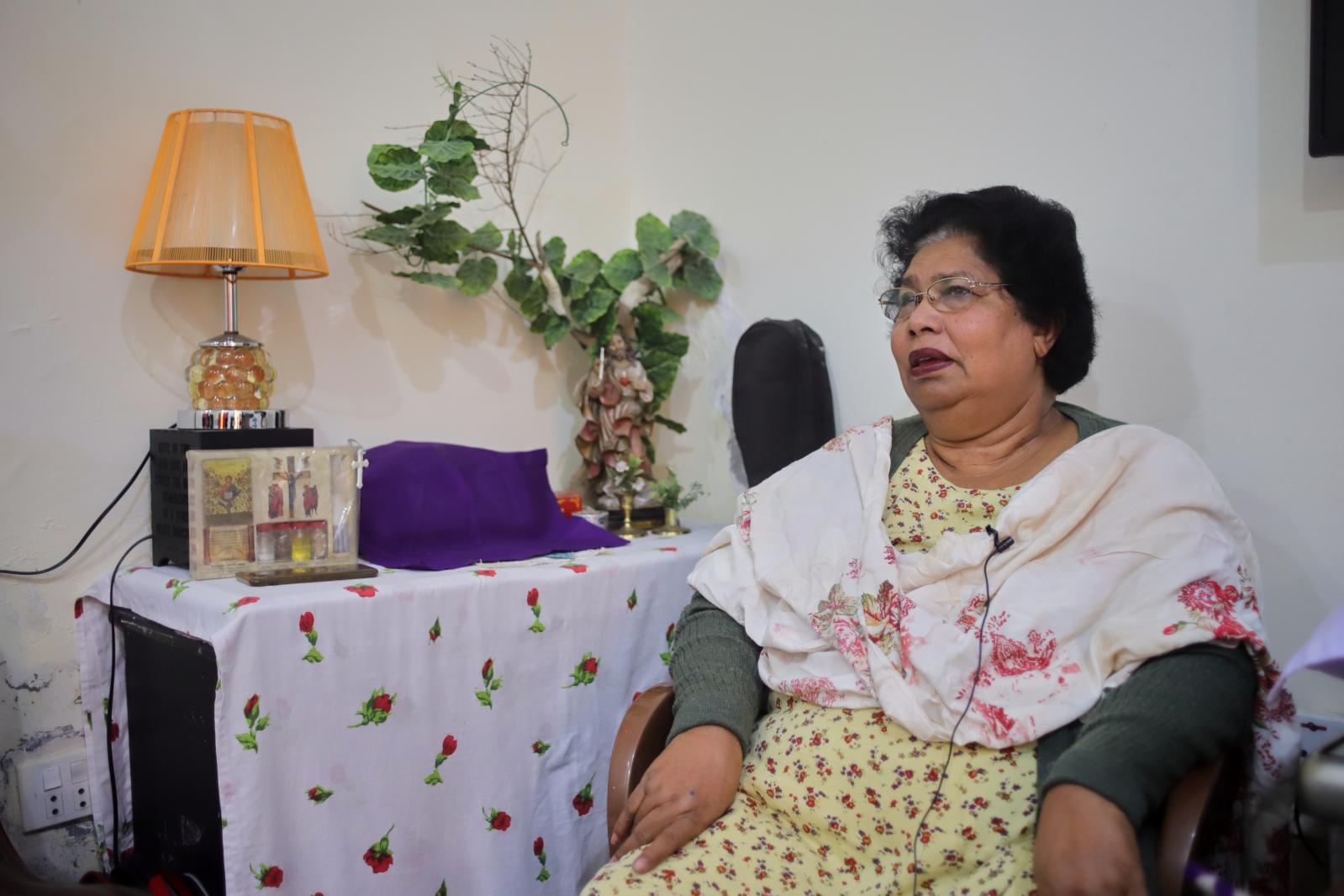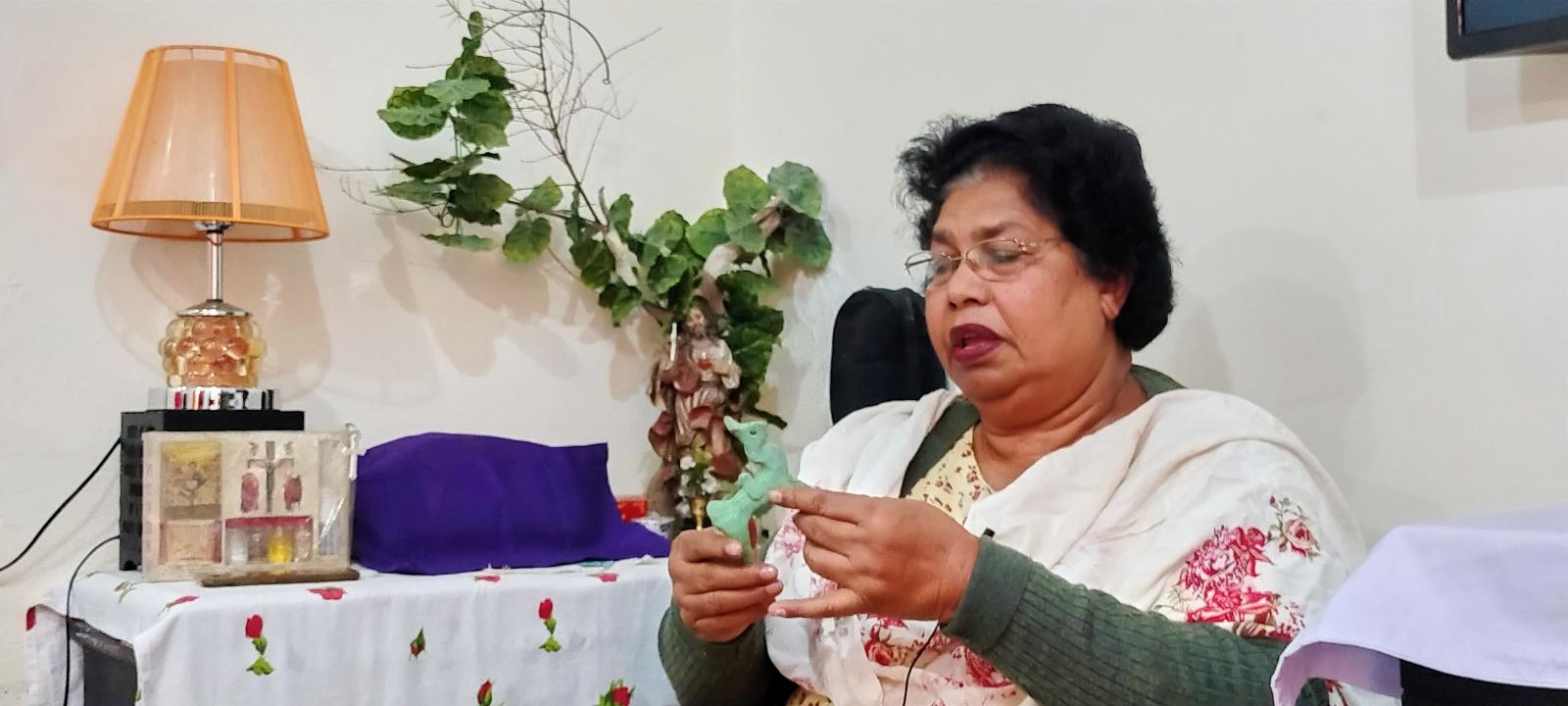Also by Waqas Manzoor —
For more access

Margaret Joseph, a physiotherapist has 40 years of experience in physiotherapy. She spent her childhood in a village adjacent to Sheikhupura. She lives in Youhanabad with her sons and daughters.

“In the evenings we used to go out at the bank of a pond just like children go to parks now, we used to go into the pond and brought out mud from there it was the best mud to make toys. We made houses having all sorts of house-based items the house used to have a boundary wall. This all was done mostly by girls because they are fond of making homes. We had boys in our company as well, our brothers as well as boys of neighbourhood, now we don’t allow our girls to go out and play. I remember, we used to play ‘Lukan Meeti’-hide and seek- in the evenings. While passing from every house in the neighbourhood we used to knock at doors, boys and girls joined us in the play and became a ‘Caravan’-group-. Boys accompanied us in all sorts of plays, sometimes we were stopped to play but we still played with boys because we did not have anything negative on our minds. We used to give ‘Chogha’-to share edibles- each other without even thinking that we have boys in our company as well.”
Our father used to bring us these bamboo sticks and we played in mud most of our childhood. The mud that is used to make earthen pots is called ‘Paan Mitti’ it was transported from a bit far and we used to bring it later grind it, add water at the night before we kneaded it for toys. We made bulls, I think this Ghora (that I had brought) is not so beautiful as we made in our childhood. I remember these toys were also part of our education in our schools. We used to be graded on these toys. We made mud houses, we made buffalos, ‘Chaati’ ‘Madhaani’ everything was made of mud. These toys were also source of education for real life preparation.”
“I have a brother who used to make ‘Gadda’-a bull cart- of mud. My mother told us these are not baked, and she taught us how to bake them by making a ditch in the ground, we put these toys in the ditch and burnt a cow dung-based fuel to bake these toys. Specially the tires of ‘Gadda’ so they don’t break. The same brother of mine later started making a tractor of mud with the passage of time toys also started transforming. But now my 3rd generation asks for mobile, TV, LCD and computer, just these gadgets. These toys were real world to us like a mud-based buffalo was treated like a real buffalo as a pet.”
“Our mother taught us how to make a stuffed doll by utilising old useless clothes we used to cut our own hair and fixed on the head of doll with glue. My father brought me a doll that I kept close all my childhood and never gave to anyone else.” Ms. Margaret shared a folk song related to dolls, she took a pause, and her eyes were full of tears.
بابل میریاں گُڈیاں تیرے گھر ریہہ گیئاں۔۔۔
My dear father I have forgotten my dolls at your house…
There are many sentiments attached to this tradition of marrying daughters and dolls used as symbols of this tradition.
Iqbal Qaiser is a Historian and a Punjabi author. His written works revolve around Sikh period, Jainism and History of Punjab. He is an ardent advocate of Punjabi language and culture. He started telling his childhood stories while I brought out all the toys I carried Ghory,Damru,Pambeeri etc.
“These toys are a rapid flashback to my childhood memories. My childhood was spent in Garden Town Lahore, there was a bungalow of Sir Chottu Ram and there was ahata-courtyard- of Lala Ganeemat Rai we used to live there. Our forefathers came to this house after the partition. There used to be a pond and adjacent to that there was an empty space and the Tapriwas-nomads- used to live in their tent houses there they used to sell these Ghgughu Ghoray, mostly women and men used to smoke Huka at house. They used to sell these toys in the barter of flour or money and sometimes they sold us toys against one roti. I remember, there used to be a cultural gathering in the night, especially as they used to spread cots outside of their tents and sing their tribal songs.”
“I was a primary school student, so I was curious and became friends with them and learnt this craft also. I was so interested in their songs. We lived in a small house I remember in the summer afternoons when mother used to sleep, and we used to get some red chili from the kitchen and exchange these toys and also got beaten by mother later. Today, these toys, siblings, mother, and her punishment, everything is a stream of sweet memory.”
On the history of these toys he told, “When we see the period of history and goes back to Harappa Civilisation, on which we find a basis of our culture, we found many artifacts and there were these clay toys as well in these artifacts like clay horses and elephants. History tells us that what a horse was to us! What was the significance of this horse at that time! We find bulls in the artifacts mostly. So, through these artifacts we started inquiring about the background of the history. They informed us about the species that were present at that time. So, these toys are not toys, only but they are sign of our history, our civilisation. They remind us of how history has changed over the course of time and who vanished and who survived.”
“Now we have everything made of plastic. You can find dolls made of plastic, even our pots are made of plastic, a clay pot can be broken but the sense of touch of clay cannot be found in plastic. We cannot eat plastic, but we eat clay, we were born in clay, we play with clay, and we will go to this dirt after our death so that relation is the older one and it will go on.”
He concluded on the couplet of Bullah Shah:
ماٹی کُدم کریندی یار
ماٹی جوڑا ماٹی گھوڑا
ماٹی دا اسوار
ماٹی کُدم کریندی یار
Jannat Ali is a Lahore based Artivist. She has been advocating for transgender rights in Pakistan and is at the forefront of this struggle. She is a classical dancer, actor and a host. She started the 1st transgender hosted show in Pakistan, titled, “Journey with Jannat.”
“In the beginning, like at the age of 6 I had the space, being a trans person I wasn’t stopped from playing with any gender specific toys, based on societal norms but the later experience as I was growing up started taking sharp turns. As a child I was more inclined towards dolls. I don’t categorise toys based on stereotypical gender segregation. I used to play with dolls and tried to stylise them by putting different kinds of dresses on them, styling their hair. I used watercolour for applying make-up on the dolls as well as on my face but when my mother used to come to me, I instantly washed my face.”
“The most vivid memory of my childhood with the toys is one in that I used to invite all my cousins for some kind of children’s party. We all used to bring one dish and eat together. I was so fond of collecting all my cousins for a gathering or celebration, I remember I used to choose such toys which have some margin of leading an event. I remember another event related to toys I used to own a stuffed teddy bear that I have given to my niece now, I used to talk to it, share my feelings when nobody understood me, I kept it with me telling stories at bedtime. It was so close to me.”
, “Our local folk doll represented local facial features like South Asians, large eyes, its nose used to be pierced and most importantly the cultural dresses it dressed in. It used to carry Gharra-pitcher- in hand and sometimes a Pankha-hand fand- so you can tell it was our own doll. I mostly saw this local doll on Melas-cultural carnvals- only. I also witnessed class system in these toys like upper middle children will have electric battery cars or Barbies. I never saw the children coming from this middle or upper middle class playing with local toys. I think from here discrimination starts that children start having an understanding that with which toys they can play and with which they can’t.”
“I think toys are planned according to the needs, fashion and culture of a particular area and it changes with the passage of time, for example, in olden times we used to have our own folk doll but with the influence of west some notions were endorsed through toys. Barbie is an example of that. As they made Barbie a demanding toy and some other items linked to that for instance Barbie’s Doll House. You would never find a toy set that has something to do with our village culture just like a Barbie house, you would never find a Village house. Then started coming automatic toys, remote control cars, gadgets and then came mobile phone and the talking toys like having Indian songs being played back mostly, I don’t think there was any research behind this. I never found any toy that played Pakistani songs. I don’t know who used to decide all this, they were manufactured in China, songs were of India and used as playthings in Pakistan. I think it has something to do with cultural and political stances behind this.”
“I found a video of mine a few days back in which I was playing with flowers and stylising a doll by transforming buntings into a hand purse and I told my parents that I was a trans-person since beginning and you always blamed that I had an influence because of my friends. I find myself playing with doll and my mother never let me buy a doll, so I used to borrow from my cousins and played. I used to stitch clothes for and after a particular age. I remember, arranging a wedding of my doll, prepared its dowry and when there was time of Rukhsati-bride’s departure- I started weeping and felt like a mother feels at the time of her daughter’s wedding. I remember my brother used to show wrath towards my doll and sometimes beat it and I stopped him from doing that by saying it’s also a human.”
Adil Javed is a tour guide in Lahore who organizes Tonga Tours of the Walled City, independently. He runs Adil Lahori Cultural Club. He was born in the Walled City and is sentimentally attached to the traditions and culture of Lahore. He shared his memories related to folk toys and his life in Walled City Lahore.
“These toys have direct or indirect relations with the tradition of Mela-cultural carnival- celebrations in Punjab particularly Lahore, I remember one of the largest Melas of Lahore used to be ‘Mela Shahlamar.’ The stalls used to range from Lahore Station to interior of Shalamar Garden and there these toys used to be sold. I remember, people used to come in groups from all around the Lahore.” He told me, “The gathering of Data Sahib’s Mela is nothing as compared to the crowd of Mela Shalamar.”
“Now we have grown up and have this realization that these toys were tools to grow together in a community and today everyone has his/her mobile and isolated in his/her room, but these toys used to bring us together. I believe that the people who played with these toys are linked to each other, and this new generation is missing this link. I was so impressed to see these Ghoray as every plaything has something to do with your memories, the amazing time associated with these toys that cannot come back. These are not toy piece only it must have some story behind as well and there used to come puppeteers who used to tell stories through puppets. They have vanished now, these are not only pieces I am stressing these are rare items and it would be a great action if they are revived.”
